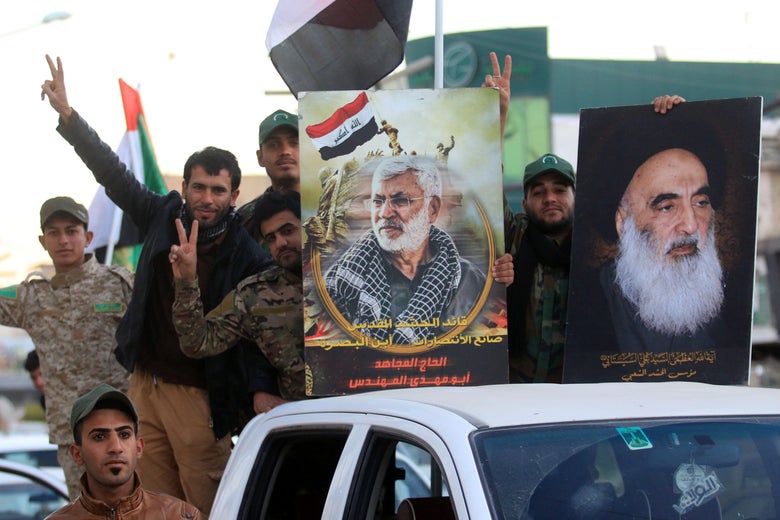
Members of the Popular Mobilization Units with portraits of Iraqi Shiite cleric Grand Ayatollah Ali al-Sistani and PMF Chairman Abu Mahdi al-Mohandes celebrate in Basra on December 10, 2017 after Baghdad declared victory in the war against the Islamic State.
HAIDAR MOHAMMED ALI/Getty Images
This week’s eruption of violence between the U.S. and Iranian-backed forces in Iraq is the predictable result of decisions dating back to the early days of the fight against ISIS in 2014. That it was so predictable doesn’t make it any less dangerous.
On Sunday, the U.S. launched airstrikes in Iraq and Syria against Kataib Hezbollah, an Iranian-backed militant group that the Pentagon blames for several attacks on U.S. facilities, including one on Friday at a base near Kirkuk that killed an American contractor and wounded four service members. But just a few years ago, this same group held an uneasy alliance with American forces in order to fend off ISIS’ takeover of Iraq.
“We will not stand for the Islamic Republic of Iran to take actions that put American men and women in jeopardy,” said Secretary of State Mike Pompeo, from the president’s residence at Mar-a-Lago. Kataib Hezbollah’s senior commander, Jamal Jaafar Ibrahimi, better known by his nom de guerre, Abu Mahdi al-Mohandes, vowed a strong response. “The blood of the martyrs will not be in vain and our response will be very tough on the American forces in Iraq,” Mohandes said in a statement.
Mohandes personifies the contradictions of U.S. policy in Iraq. The commander both has strong ties to Iran and significant leverage over the Iraqi state. Not surprisingly, Iraqi Prime Minister Adil Abdul Mahdi, who was informed about the U.S. strikes by Defense Secretary Mark Esper just half an hour before they happened, condemned the action, with a spokesman calling the strikes a “treacherous stab in the back.”
At the same time the U.S. is putting “maximum pressure” on the government of Iran, it is nominally allied with and financially supporting Iraq, a country that is also reliant upon—some would say dominated by—America’s main regional rival, Iran.
Long committed to establishing a Shiite religious state in Iraq, Mohandes received military training from the Revolutionary Guard Corps in Iran during the 1980s while the two countries were at war. He was implicated in the bombing of U.S. and French embassies in Kuwait and later designated as a terrorist by the U.S. Treasury Department. He returned to Iraq after the U.S. invasion in 2003 and served in parliament, while also allegedly organizing the Iran-backed Shiite militias carrying out deadly attacks against U.S. forces. He fled back to Iran, where his family still lives and where he has citizenship, to avoid arrest by U.S. officials. He is also reportedly an adviser to Qassem Soleimani, commander of Iran’s Quds force, which supports foreign groups including Hezbollah and Hamas.
Mohandes’ fortunes turned again in 2014, when ISIS overran Iraq. With Iraq’s weakened military in a state of collapse, Iraqi Shiites began joining Iranian-backed militia groups in order to fight back against ISIS, including Mohandes’s Kataib Hezbollah. With the fall of Baghdad looking like a very real possibility, then Prime Minister Nouri al-Maliki backed the militias and put Mohandes in charge of organizing them.
Given the slow pace of rebuilding Iraq’s official military and the U.S. reluctance to commit ground troops, the militias, organized under an umbrella group called the Popular Mobilization Forces (PMF), were critical to the eventual retaking of Iraq from ISIS. But it also put U.S. forces in the uncomfortable position of fighting on the same side, and in some cases even providing air cover for, the militias that had been killing them just a few years earlier.
The role of figures like Mohandes in the PMF was seen as problematic from early on. But given the speed of ISIS’s spread, the Obama administration didn’t have many other options at that point.
In the post-ISIS era, the tensions are getting harder to ignore. Earlier this year, current Prime Minister Adil Abdul Mahdi ordered the PMF to be formally integrated into the Iraqi military, but many analysts believe this simply legitimized their presence and increased their leverage over the Iraqi state. Though technically deputy commander, Mohandes is generally considered the leader of the PMF, a position that gives significant leverage via his control of funding for armed groups.
Even as tensions continue to rise between the U.S. and Iran, there’s little appetite on either side for direct military confrontation. But that means we’re more likely to see proxy battles between the two sides throughout the region. Because both the U.S. and Iran are so deeply enmeshed in Iraqi politics, it may well turn out to be ground zero for this conflict.
Further complicating the picture are Iraq’s ongoing protests, which are at least partly aimed at Iran’s influence over a political system many Iraqis see as corrupt and unresponsive. In theory, this could provide an opening for the U.S. to use diplomatic resources, not just sanctions and airstrikes, to counter Iranian influence. It wouldn’t be an easy task given the last two decades, but the U.S. could try to stabilize Iraqi politics and prevent the chaos and sectarianism that allowed ISIS to rise after the last time U.S. troops withdrew in 2011.
But the Trump administration is cutting the number of diplomats in Iraq, so that possibility will probably remain theoretical.
Readers like you make our work possible. Help us continue to provide the reporting, commentary and criticism you won’t find anywhere else.
Join Slate Plusfrom Slate Magazine https://ift.tt/2ZEEfdn
via IFTTT
沒有留言:
張貼留言